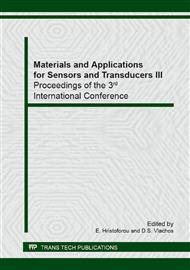p.495
p.499
p.503
p.507
p.511
p.515
p.519
p.523
p.527
Drift-Like Terms Minimization in the Responses of a Generic Tin Oxide Gas Sensor
Abstract:
The responses of a tin oxide gas sensor vary with humidity level in the surrounding atmosphere. Such response variations can cause error in the estimation of the concentration level of the target gas and need compensation measures. Different methods have been used to compensate the effect of humidity, which usually require utilization of other parallel environmental sensors and costly data fusion methodology. Particularly, such a drift alters the response patterns obtained from a real or virtual sensor array and hinders gas recognition. Here, we report response patterns recorded from a virtual array made by operating temperature modulation at different ambient humidity levels for three different target gases. Humidity level varied from 30-70% and response patterns were recorded for methanol, ethanol and 1-propanol at a wide concentration range. It is shown that by utilizing the thermal shock-induction method for the temperature modulation of the sensor, the drift levels are low, and with a single set of training data collected at RH=50%, responses obtained in the whole humidity range can be discriminated from each other. The clusters volumes in the feature space grow with the span of the ambient humidity variations, but they remain separate allowing gas recognition.
Info:
Periodical:
Pages:
511-514
Citation:
Online since:
April 2014
Authors:
Price:
Сopyright:
© 2014 Trans Tech Publications Ltd. All Rights Reserved
Share:
Citation:


